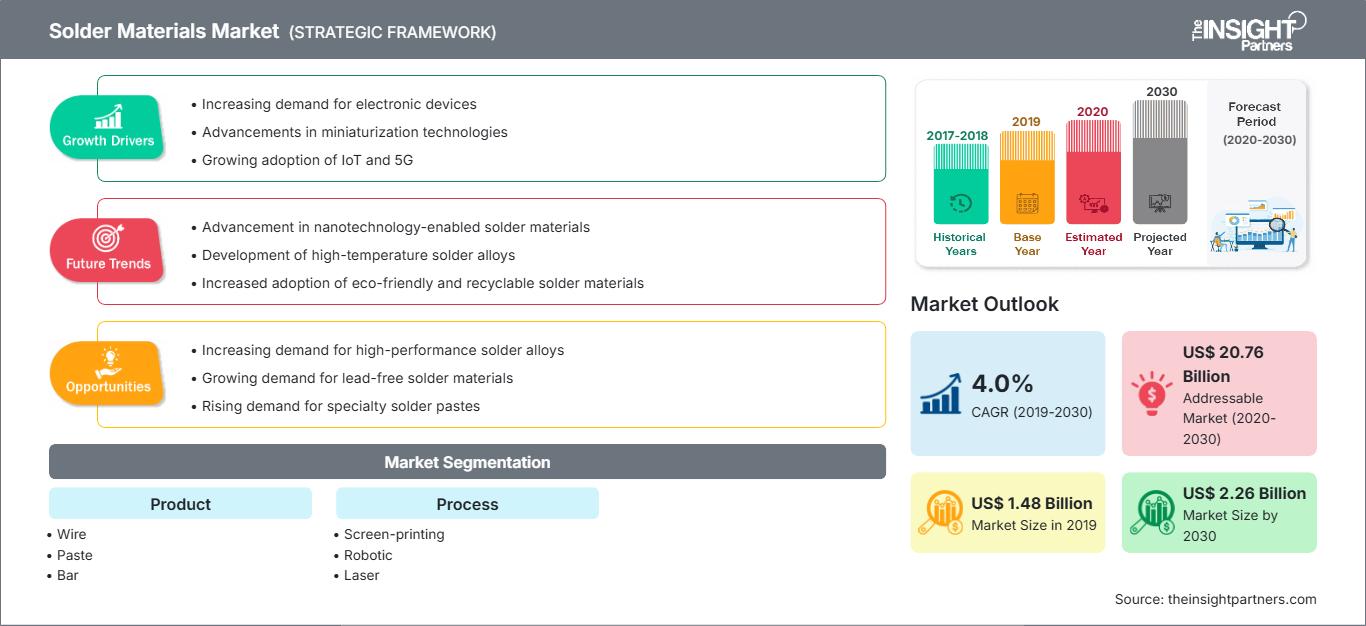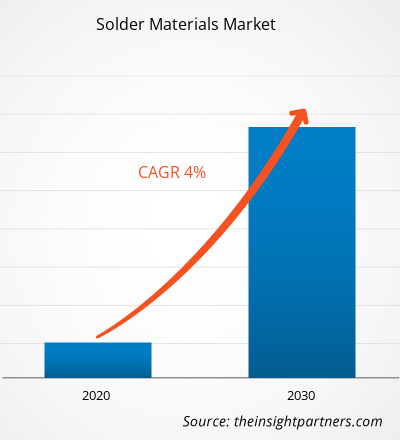Der Markt für Lötmaterialien hatte im Jahr 2019 einen Wert von 1.477,2 Millionen US-Dollar und soll von 2020 bis 2030 mit einer durchschnittlichen jährlichen Wachstumsrate von 4,0 % wachsen und bis 2030 2.255,3 Millionen US-Dollar erreichen.
Löten ist ein Verfahren, bei dem zwei oder mehr Metalle durch Schmelzen miteinander verbunden und anschließend ein Füllmetall, Lot genannt, in die Verbindung eingebracht wird. Das dabei verwendete Füllmetall hat einen niedrigeren Schmelzpunkt als das angrenzende Metall. In den vergangenen Jahrzehnten enthielten fast alle Lote Blei. Umwelt- und Gesundheitsbedenken der Verbraucher haben jedoch zunehmend die Verwendung bleifreier Legierungen für Elektronik- und Sanitärzwecke erforderlich gemacht. Lot wird in der Elektronik, im Sanitärbereich, im Bauwesen und in der Metallverarbeitung zum Versiegeln von Schmuck, Medizinprodukten und Musikinstrumenten verwendet. Lötmittel dienen hauptsächlich zur Herstellung einigermaßen dauerhafter, aber reversibler Verbindungen zwischen Kupferrohren in Sanitärsystemen sowie Verbindungen in Blechgegenständen wie Konservendosen, Regenrinnen, Dacheindeckungen und Autokühlern. Elektroniklot verbindet elektrische Leitungen mit Geräten und elektronische Komponenten mit Leiterplatten.
Der globale Markt für Lötmaterialien im asiatisch-pazifischen Raum wird zwischen 2020 und 2030 voraussichtlich mit einer durchschnittlichen jährlichen Wachstumsrate von 4,2 % wachsen. Die hohe Nachfrage nach Lötmaterialien und die Hinwendung der Verbraucher zu intelligenten elektronischen Produkten in dieser Region schaffen eine starke Basis für den Markt für Lötmaterialien. Mit einem derart beträchtlichen Wachstum wird der asiatisch-pazifische Raum im Prognosezeitraum die attraktivste Region für den Markt für Lötmaterialien sein.
Der Ausbruch von COVID-19, der im Dezember 2019 in Wuhan (China) begann, hat sich rasant über den Globus verbreitet. Im Juni 2020 gehörten die USA, Russland, Indien, China, Italien, Spanien, Frankreich und Deutschland hinsichtlich positiver Fälle und gemeldeter Todesfälle zu den am stärksten betroffenen Ländern. Laut den im Juni 2020 aktualisierten Zahlen der WHO wurden weltweit etwa 7.482.952 bestätigte Fälle und 419.497 Todesfälle gemeldet. Der Ausbruch hat Volkswirtschaften und Industrien aufgrund von Lockdowns, Reiseverboten und Betriebsschließungen beeinträchtigt. Die Chemie- und Werkstoffindustrie ist eine der weltweit wichtigsten Branchen, die infolge der Pandemie unter schweren Störungen wie Lieferkettenunterbrechungen, der Absage von Technologieveranstaltungen und Büroschließungen leidet. China ist das globale Produktionszentrum und der größte Rohstofflieferant für verschiedene Branchen; es ist jedoch auch eines der am stärksten von der COVID-19-Pandemie betroffenen Länder. Die Schließung verschiedener Werke und Fabriken in China beeinträchtigt die globalen Lieferketten und wirkt sich negativ auf die Herstellung und den Verkauf verschiedener Chemikalien und Materialien aus. Der allgemeine Markteinbruch aufgrund von COVID-19 beeinträchtigt auch das Wachstum des Lötmaterialmarktes aufgrund von Fabrikschließungen, Hindernissen in der Lieferkette und dem Abschwung der Weltwirtschaft.
Sie erhalten kostenlos Anpassungen an jedem Bericht, einschließlich Teilen dieses Berichts oder einer Analyse auf Länderebene, eines Excel-Datenpakets sowie tolle Angebote und Rabatte für Start-ups und Universitäten.
Markt für Lötmaterialien: Strategische Einblicke

- Holen Sie sich die wichtigsten Markttrends aus diesem Bericht.Dieses KOSTENLOSE Beispiel umfasst Datenanalysen, die von Markttrends bis hin zu Schätzungen und Prognosen reichen.
Markteinblicke: Steigende Nachfrage aus der Elektronikindustrie fördert globales Wachstum des Lötmaterialmarktes
Die steigende Nachfrage nach intelligenter Elektronik und die Einführung energieeffizienter Elektronik sind die Hauptfaktoren für das Wachstum des Lötmaterialmarktes. Darüber hinaus wird erwartet, dass die steigende Produktion von elektronischen Geräten oder Gadgets in Entwicklungsländern in Verbindung mit der Präsenz einer bedeutenden Elektronik-Ersatzteilindustrie die Nachfrage nach Lötmaterial ankurbeln wird. Herkömmliche Mikrometer-Lötmaterialien in der Paste weisen mehrere Nachteile auf, wie z. B. hohe Schmelztemperaturen, die zu unerwünschten Spannungen während des Reflow-Prozesses, eingeschränkten Anwendungsmöglichkeiten und Defekten in der Verbindung führen können. Dies hat zur Einführung innovativer Lötmaterialien auf Submikrometer- und Nanopartikelbasis geführt. Diese Fortschritte im Bereich der Elektronikaufbereitung werden daher voraussichtlich das Wachstum des globalen Lötmaterialmarktes vorantreiben. In der Elektronikindustrie werden verschiedene Arten von Lötmaterialien verwendet, wie z. B. bleifreies Lot, Lötdraht, Lötkugeln und Lötstäbe. Bleifreie Lote werden aufgrund gesetzlicher Vorschriften und der gesundheitlichen und ökologischen Vorteile durch den Verzicht auf bleihaltige elektronische Bauteile in fast allen Anwendungen zunehmend eingesetzt. Sie werden hauptsächlich in der Unterhaltungselektronik verwendet. Für Arbeiten in der Elektro- und Elektronikindustrie ist Lötdraht in verschiedenen Stärken für Handlöten und mit flussmittelhaltigen Kernen erhältlich.
Produkteinblicke
Der Markt für Lötmaterialien ist produktbezogen in Draht, Paste, Stangen, Flussmittel und Sonstiges unterteilt. Das Drahtsegment hatte 2019 den größten Anteil am Weltmarkt, während für den Markt für Paste im Prognosezeitraum die höchste durchschnittliche jährliche Wachstumsrate (CAGR) erwartet wird. Lötdraht besteht aus verschiedenen Legierungen oder reinem Zinn. Da die Metallkombinationen, aus denen Lötdraht besteht, bei unterschiedlichen Temperaturen schmelzen, benötigt jedes Metall eine bestimmte Art von Lötdraht, um starke Verbindungen herzustellen. Die am häufigsten in Lötdraht verwendeten Metalle sind Blei (Pb) und Zinn (Sn). Weichlot schmilzt grundsätzlich im Bereich von 190–900 °F. Bleifreie Lote werden zunehmend verwendet, um gesetzlichen Anforderungen gerecht zu werden und um gesundheitliche und ökologische Vorteile durch die Vermeidung bleihaltiger elektronischer Komponenten zu erzielen. Sie werden hauptsächlich in der Unterhaltungselektronik eingesetzt.
Prozesseinblicke
Basierend auf dem Prozess ist der Markt für Lötmaterialien in Siebdruck, Robotertechnik, Laser und Welle/Reflow unterteilt. Das Segment Welle/Reflow hatte 2019 den größten Anteil am globalen Markt für Lötmaterialien; während für das Robotersegment im Prognosezeitraum die höchste durchschnittliche jährliche Wachstumsrate erwartet wird. Wellenlöten ist ein Lötverfahren im großen Maßstab, bei dem elektronische Komponenten hauptsächlich auf eine Leiterplatte (PCB) gelötet werden, um eine elektronische Baugruppe zu bilden. Der Name leitet sich im Wesentlichen davon ab, dass Wellen aus geschmolzenem Lot verwendet werden, um Metallkomponenten auf der Leiterplatte zu befestigen. Bei diesem Verfahren wird ein Tank mit geschmolzenem Lot verwendet. Die Bauteile werden in die Leiterplatte eingesetzt. Anschließend wird die bestückte Leiterplatte durch eine Lötschwall- oder -wasserfallpumpe geführt. Reflow-Löten ist ein Verfahren, bei dem eine oder mehrere kleine elektrische Bauteile mit Lötpaste vorübergehend an ihren Kontaktflächen befestigt werden. Anschließend wird die gesamte Baugruppe kontrolliert erhitzt. Die Lötpaste fließt zurück und kann im geschmolzenen Zustand dauerhafte Lötverbindungen bilden. Die Erwärmung erfolgt bei diesem Verfahren, indem die Baugruppe durch einen Reflow-Ofen oder eine Infrarotlampe geführt oder einzelne Verbindungen mit einem Heißluftkolben gelötet werden.
Markt für LötmaterialienMarkt für Lötmaterialien
Die Analysten von The Insight Partners haben die regionalen Trends und Faktoren, die den Markt für Lötmaterialien im Prognosezeitraum beeinflussen, ausführlich erläutert. In diesem Abschnitt werden auch die Marktsegmente und die geografische Lage in Nordamerika, Europa, dem asiatisch-pazifischen Raum, dem Nahen Osten und Afrika sowie Süd- und Mittelamerika erörtert.Umfang des Marktberichts zu Lötmaterialien
| Berichtsattribut | Einzelheiten |
|---|---|
| Marktgröße in 2019 | US$ 1.48 Billion |
| Marktgröße nach 2030 | US$ 2.26 Billion |
| Globale CAGR (2019 - 2030) | 4.0% |
| Historische Daten | 2017-2018 |
| Prognosezeitraum | 2020-2030 |
| Abgedeckte Segmente |
By Produkt
|
| Abgedeckte Regionen und Länder | Nordamerika
|
| Marktführer und wichtige Unternehmensprofile |
|
Marktdichte der Akteure im Bereich Lötmaterialien: Auswirkungen auf die Geschäftsdynamik verstehen
Der Markt für Lötmaterialien wächst rasant. Die steigende Nachfrage der Endverbraucher ist auf Faktoren wie veränderte Verbraucherpräferenzen, technologische Fortschritte und ein stärkeres Bewusstsein für die Produktvorteile zurückzuführen. Mit der steigenden Nachfrage erweitern Unternehmen ihr Angebot, entwickeln Innovationen, um den Bedürfnissen der Verbraucher gerecht zu werden, und nutzen neue Trends, was das Marktwachstum weiter ankurbelt.

- Holen Sie sich die Markt für Lötmaterialien Übersicht der wichtigsten Akteure
- Progressive Branchentrends auf dem globalen Markt für Lötmaterialien, die den Akteuren bei der Entwicklung effektiver langfristiger Strategien helfen
- Geschäftswachstumsstrategien in entwickelten und sich entwickelnden Märkten
- Quantitative Analyse des globalen Marktes für Lötmaterialien von 2017 bis 2030
- Schätzung der globalen Nachfrage nach Lötmaterialien in verschiedenen Endverbrauchsbranchen
- PEST-Analyse zur Veranschaulichung der Wirksamkeit von Käufern und Lieferanten der Branche zur Vorhersage des Marktwachstums
- Jüngste Entwicklungen zum Verständnis des Wettbewerbsmarktszenarios und der globalen Nachfrage nach Lötmaterialien
- Markttrends und -aussichten sowie Faktoren, die das Wachstum des globalen Marktes für Lötmaterialien vorantreiben und hemmen
- Verständnis der Strategien, die das kommerzielle Interesse im Hinblick auf das Wachstum des globalen Marktes für Lötmaterialien untermauern, was einen effektiven Entscheidungsprozess erleichtert
- Globale Marktgröße für Lötmaterialien an verschiedenen Marktknotenpunkten
- Detaillierte Übersicht und Segmentierung des globalen Marktes für Lötmaterialien sowie seine Dynamik in der Industrie
- Globale Marktgröße für Lötmaterialien in verschiedenen Regionen mit vielversprechenden Wachstumschancen in den jeweiligen Märkten
Markt für Lötmaterialien nach Produkt
- Draht
- Paste
- Riegel
- Flussmittel
- Sonstige
Markt für Lötmaterialien nach Verfahren
- Wellen-/Reflow-Lötverfahren
- Roboter
- Siebdruck
- Laser
Firmenprofile
- Fusion Incorporated
- Indium Corporation
- Kester
- KOKI Company Ltd
- Lucas-Milhaupt, Inc.
- Qualitek International, Inc.
- Senju Metal Industry Co., Ltd.
- Stannol GmbH & Co. KG
- TAMURA Corporation
- Nihon Genma
- Historische Analyse (2 Jahre), Basisjahr, Prognose (7 Jahre) mit CAGR
- PEST- und SWOT-Analyse
- Marktgröße Wert/Volumen – Global, Regional, Land
- Branchen- und Wettbewerbslandschaft
- Excel-Datensatz
Aktuelle Berichte
Erfahrungsberichte
Grund zum Kauf
- Fundierte Entscheidungsfindung
- Marktdynamik verstehen
- Wettbewerbsanalyse
- Kundeneinblicke
- Marktprognosen
- Risikominimierung
- Strategische Planung
- Investitionsbegründung
- Identifizierung neuer Märkte
- Verbesserung von Marketingstrategien
- Steigerung der Betriebseffizienz
- Anpassung an regulatorische Trends




















 Kostenlose Probe anfordern für - Markt für Lötmaterialien
Kostenlose Probe anfordern für - Markt für Lötmaterialien